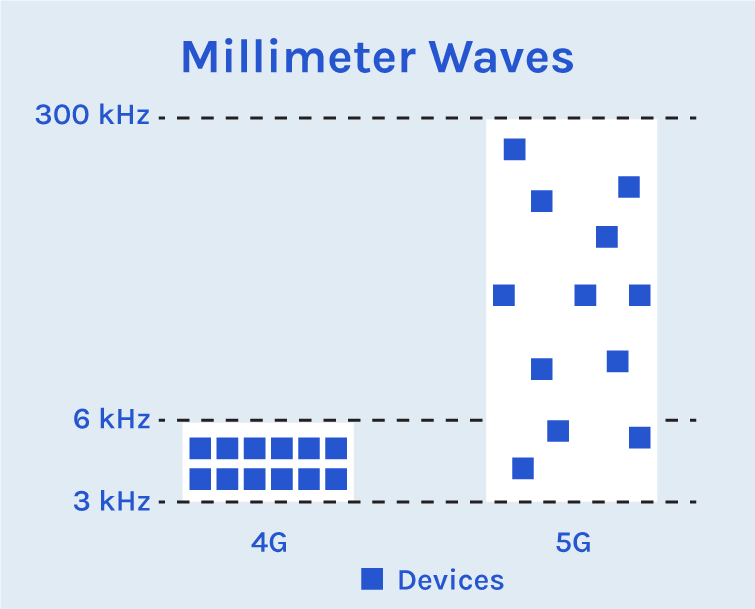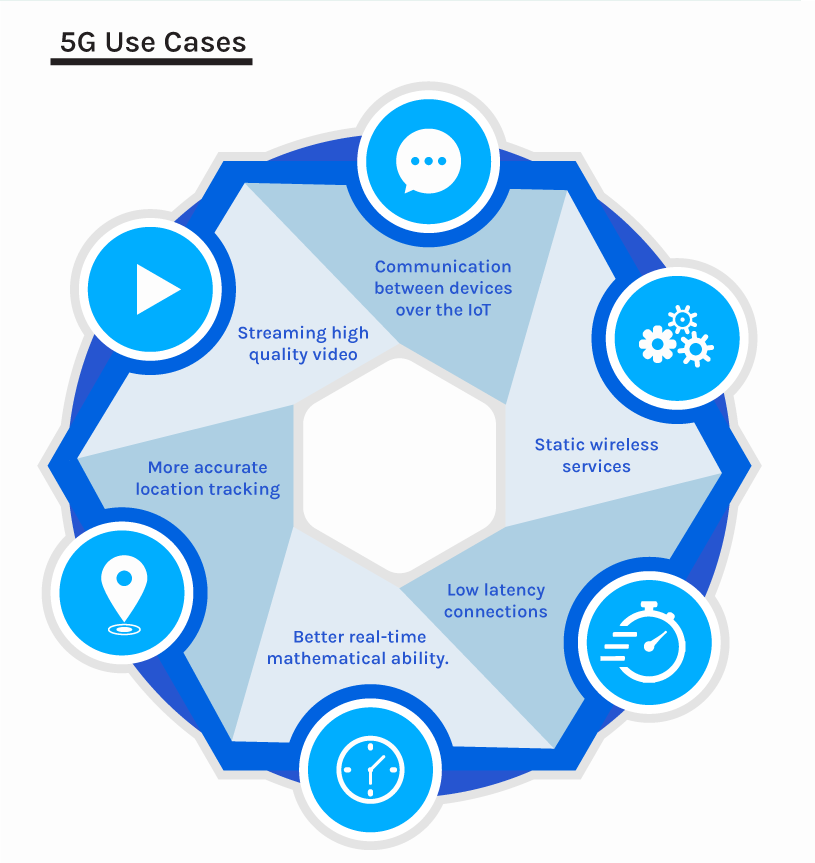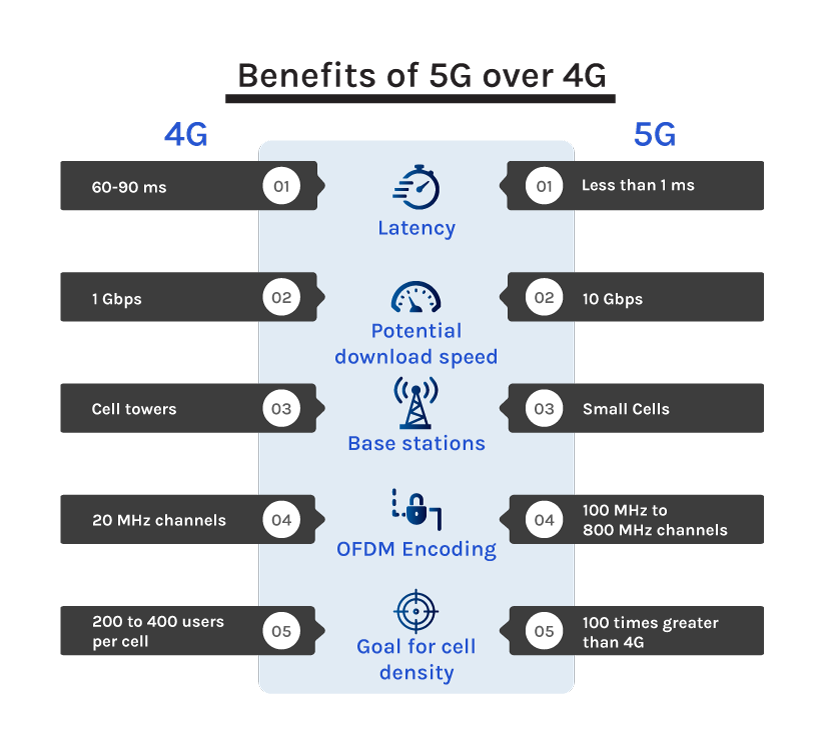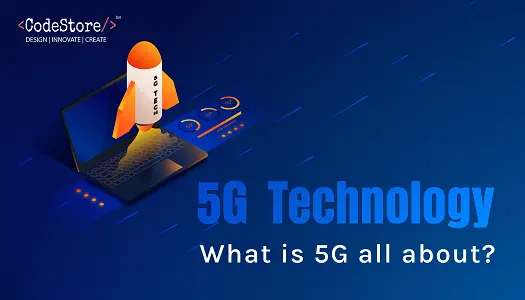Introduction
Fifth generation wireless (5G) is the latest addition to mobile technology, designed to significantly increase the speed and response of wireless networks. With 5G, data transmitted over a wireless broadband connection can go at multi-gigabit speeds, with a maximum speed of up to 20 gigabits per second (Gbps). These speeds exceed telephone network speeds and provide a delay of 1 millisecond (ms) or less, which is useful for applications that require real-time feedback. 5G will significantly increase the amount of data transmitted by wireless systems because of available bandwidth and advanced antenna technology.
5G networks and services will be deployed in phases over the next few years to meet increasing reliance on mobile and internet devices. Overall, 5G is expected to produce a wide variety of new applications, uses and business cases as the technology is released.
How Does 5G Work?
Wireless communication systems use radio waves (also known as spectrum) to transmit information over the air.
5G works the same way, but uses less high-density radio waves. This allows it to carry more information at a faster rate. These top bands are called ‘millimeter waves’ (mmwave). They may not have been used before but have been opened up for licensing by regulators.
Although higher bands are quick to handle information, there may be problems with sending it to enormous distances. They are easily blocked by tangible objects, such as trees and buildings. To avoid this challenge, 5G will use multiple input and output horns to maximize signals and capacity across the wireless network.
The technology will also use smaller transmitters installed in buildings and street furniture, instead of using independent pillars alone. Current estimates say that 5G will support up to 1,000 more devices per meter than 4G.

5G technology will also be able to ‘cut’ the physical network into multiple virtual networks. This means that operators will deliver the right piece of network, depending on how it is used. This means, for example, that the operator will use different components depending on the value. Therefore, a single video streaming user can use a separate piece in the business, while simple devices can be separated into more complex and more demanding programs, such as private car controls.
There are also plans to allow businesses to rent their own separate piece of network to separate them from online traffic competition.
Who Invented the Fifth Generation Network?
The first nation to adopt on the large scale was South Korea, in April 2019 there were about 224 employees in 88 countries around the world investing in technology.
In South Korea, all 5G carriers use the channels and basic equipment of Samsung, Ericsson and Nokia, except for those using Huawei equipment. Of these providers, Samsung was the largest, delivering 53,000 base stations from 86,000 base stations installed in the country.
There are currently nine companies selling 5G radio hardware and carrier systems. These are Altiostar, Cisco Systems, Datang Telecom, Ericsson, Huawei, Nokia, Qualcomm, Samsung and ZTE.
What are the advantages of the 5G Network over the 4G Network?
The most obvious advantage of 5G networks over 4G networks is speed. However, there are also advantages to reduce latency – which means faster response times and faster download speeds. This opens up a whole range of applications that can be available across the industry due to improved efficiency.
Among the applications of 5G are high-speed wireless broadband for mobile phones, 5G mobile communications, smart factory construction, holographic technology, televisions, remote health care, and non-motorized vehicles with 5G connections and car-to-car communications.
Many of these technological advances will be achieved through reduced delays, allowing 5G devices to respond to commands faster. Delay between the order issued, and the response received. 3G has a latency of 65 milliseconds, advanced 4G has 40 milliseconds of latency, while scheduled broadband has a latency of between 10-20 milliseconds. By comparison, 5G is expected to operate with 1 millisecond of delay, allowing critical applications and internet-enabled to operate below the target of 4 milliseconds of improved broadband service.
The technology will also boost a larger capacity than previous network technologies. It will have access to a larger spectrum at higher frequencies, so networks will handle on-demand applications simultaneously. This means it can provide a fiber-like feel to fixed wireless systems, allowing those in hard-to-reach areas to enjoy a much more advanced broadband service.
As mentioned above, the main 5G market area is related to network speed. Some say high speeds can eventually exceed 10Gps.
What types of 5G wireless services will be available?
Network operators are developing two types of 5G services:
- 5G wireless broadband services bring internet access to homes and businesses without wiring in buildings. To do so, network operators broadcast NRs to small cell sites near buildings to transmit signal to the receiver on the roof or in a magnified window inside buildings. Flexible broadband services are expected to make it less expensive for operators to deliver broadband services to homes and businesses as this eliminates the need to remove fiber optic cables from all residential areas. Instead, operators only need to install fiber optics on mobile sites, and customers receive broadband services via wireless modems available in their residences or businesses.
- 5G cellular services provide user access to operators’ 5G cellular networks. These services were first launched in 2019 when the first 5G (or compliant) enabled device became commercially available. Delivery of mobile services also depends on the completion of key mobile standards through 3GPP.
5G use cases
5G usage cases can range from business and commercial use to normal consumer use. Some examples of how 5G can be used include:

- streaming high quality video;
- communication between devices over the Internet of Things (IoT);
- more accurate location tracking;
- static wireless services;
- Low latency connections and
- better real-time mathematical ability.
Besides improvements in speed, capacity and latency, 5G offers network management features – among them network cuts, enabling mobile operators to create multiple virtual networks within a single virtual 5G network. This capability will enable the wireless network connection to support specific uses or business situations and can be marketed as a service-based basis. Self-driving cars, for example, may need a piece of network that provides high-speed, low-speed connectivity so that the car can roam in real time. A home appliance, however, can be connected with low power, slow connection because high performance is not essential. IoT can use secure, data-only connections.
Benefits of 5G over 4G

Bottom Line
While consumed benefits of fast, reliable connectivity and low latency are clear, 5G will bring real business benefits.
5G will provide improved working conditions away from employees and save time and be more productive as there will be less need for mobility.
Network cuts will allow companies to have their own dedicated networks to suit their specific needs, while improved speed and latency will have a positive impact on efficiency and productivity.
Rural communities will also be better connected, which will allow for more business opportunities in these areas.
Although 5G is not yet ready for worldwide use, action is being taken to make this happen. Once technology is fully developed, it can drastically change the way we both live and work.
If you are planning to develop your own mobile apps with 5G Technology, then share your queries with us or get in touch with us at sales@codestoresolutions.com.

